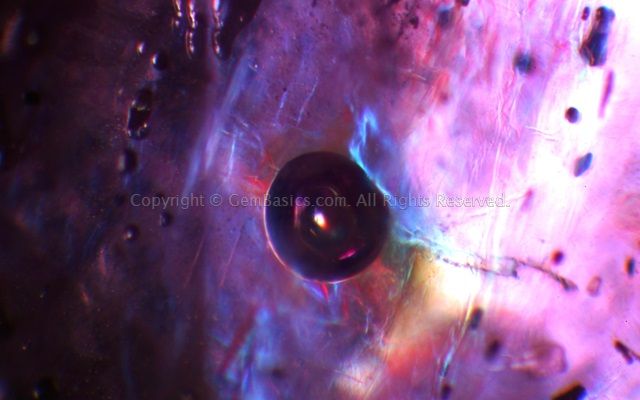www.GemstoneBasics.com
Photomicrography > Corundum > Glass-filled rubies
First draft: May 15th, 2014 | Last update: March 18th, 2016
Diagnostic Features of Glass-Filled Rubies
Lead (Pb) Glass
Lead (Pb) glass filled rubies started to appear on the market during the early 2000s. Gem labs responded promptly by issuing lab alerts covering all characteristics of the new kid on the block, but the treatment evolved further. In the beginning, only Malagasy material was used, but that has changed.
Secondly, fractures were only thin fissures back then, and dealers were very reluctant to admitting that these stones were treated with glass. But today stones containing more than 60% of glass are encountered. Such stones are called reconstructed ruby.
While it seems that a semantic discussion is unfolding about whether or not rubies should be classified as reconstructed or composed, it is clear that the treatment is both drastic and conspicuous enough to ask yourself the question whether this material should actually be called ruby.
References and items of related interest
Anonymous (2008). Update on an uncommon lead-glass treated ruby. Gem & Jewelry Institute of Thailand Online Report on Gem & Jewelry Institute of Thailand
Anonymous (2012). Corundum: with glass filled fissures, with glass filled cavities, with/and glass (manufactured product). Laboratory Manual Harmonization Committee Information Sheet, No. 3, Version 9, last updated December 2012 on www.lmhc-gemology.org
Chatagnier, P.-Y., Fritsch, E., Rondeau, B., Karampelas, S. & Gaillou, E. (2011). Un surprenant triple corindon - verre au plomb. Revue de Gemmologie, Association Française de Gemmologie, No. 178, pp. 17-20 (in French).
de Vincenti, C. (2012). Rubis et saphirs sont de plus en plus traites (1e partie). Gold'Or, No. 6, pp. 62-63 (in French).
de Vincenti, C. (2012). Rubis et saphirs sont de plus en plus traites (2e partie). Gold'Or, No. 7, pp. 68-69 (in French).
Dunaigre, C. (2000). Remplissage et cicatrisation des fissures dans les rubis. Diplôme d'Université de Gemmologie (DUG) Dissertation, University of Nantes (in French).
Emmett, J.L. (1999). Fluxes and the Heat Treatment of Ruby and Sapphire. Gems & Gemology, Vol. 35, No. 3 (Fall), pp. 90-92.
Hänni, H.A. (1986). Behandelte Korunde mit glasartigen Fallungen. Gemmologie: Zeitschrift der Deutschen Gemmologischen Gesellschaft, Vol. 35, Nos. 3-4, pp. 87-96 (in German). Also published on www.ssef.ch
Hänni, H.A. (2001). Beobachtungen an hitzebehandeltem Rubin mit künstlicher Rissheilung. Gemmologie: Zeitschrift der Deutschen Gemmologischen Gesellschaft, Vol. 50, No. 3, pp. 123-136 (in German). Also published on www.ssef.ch
Hughes, R.W. (1984). Surface Repaired Rubies. The Australian Gemmologist, Vol. 15, No. 8 (November), pp. 279-280.
Hughes, R.W. (1988). Surface repaired corundum—two unusual variations. The Journal of Gemmology, Vol. 21, No. 1, pp. 8-10.
Hughes, R.W. & Emmett, J.L. (2004). Fluxed Up: The Fracture Healing of Ruby on www.ruby-sapphire.com
Hughes, R.W. & Koivula, J.I. (2005). The synthetic healing of ruby. AGTA GTC’s Laboratory Update, November 30.
Kane, R.E. (1984). Natural Rubies with Glass-Filled Cavities. Gems & Gemology, Vol. 20, No. 4 (Winter), pp. 187-199.
Koivula, J.I. (1986). Carbon Dioxide Fluid Inclusions as Proof of Natural-Colored Corundum. Gems & Gemology, Vol. 22, No. 3 (Fall), pp. 152-155.
McClure, S.F. & Smith, C.P. (2000). Gemstone Enhancement and Detection in the 1990s. Gems & Gemology, Vol. 36, No. 4, pp. 336-359.
Nassau, K. (1981). Heat Treating Ruby and Sapphire: Technical Aspects. Gems & Gemology, Vol. 17, No. 3 (Fall), pp. 121-131.
Nassau, K. (1984). The Early History of Gemstone Treatments. Gems & Gemology, Vol. 20, No. 1 (Spring), pp. 22-33.
Pardieu, V. (2005). Identification des corindons chauffés avec addition de verre au plomb. Revue de Gemmologie, Association Française de Gemmologie, No. 152 (Juin), pp. xxx-xxx (in French).
Pardieu, V. (2005). Lead glass filled/repaired rubies. Asian Institute of Gemological Sciences Gem Testing Laboratory Online Report on www.fieldgemology.org
Pemadasa, T.G. & Danapala, M.V. (1994). Heat treated corundums of Sri Lanka: their heat treatment. The Australian Gemmologist, August, pp. 346-347.
Pisutha-Arnond, V., Häger, T., Atichat, W. & Wathanakul, P. (2006). The role of Be, Mg, Fe and Ti in causing colour in corundum. The Journal of Gemmology, Vol. 30, No. 3-4, pp. 131-143.
Rockwell, K.M. & Breeding, C.M. (2004). Rubies, Clarity Enhanced with a Lead Glass Filler. Gems & Gemology, Vol. 28, No. 2 (Summer), pp. 112-115.
Scarratt, K. & Harding, R.R. (1984). Glass Infilling of Cavities in Natural Ruby. The Journal of Gemmology, Vol. 19, No. 4, pp. 293-297.
Scarratt, K. (2012). A discussion on ruby-glass composites & their potential impact on the nomenclature in use for fracture-filled or clarity enhanced stones in general. Gemological Institute of America Online Report on www.giathai.net
Themelis, T. (1992). The Heat Treatment of Ruby and Sapphire. 1st Ed., Gem Lab Inc., Clearwater, Florida, 236 p. ISBN 0-940965-10-0.
Themelis, T. (2004). Flux-Enhanced Rubies & Sapphires. Private publication, Bangkok, 48 p. ISBN 0-940965-42-9.
Photomicrographs
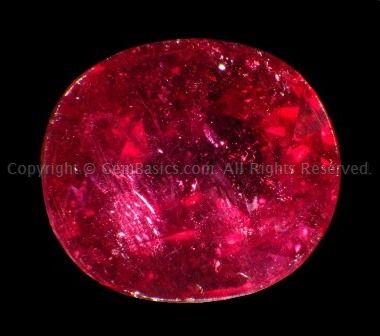
General image of a 2.54ct glass-filled ruby (2005)
6x (FoV ± 5mm) Obl, DF, Pol

1.71ct glass-filled ruby; purchased in 2008
6x (FoV ± 5mm) Obl, DF, Pol
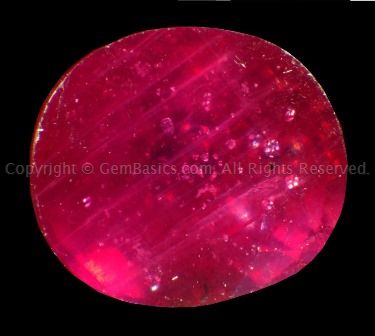
And yet another general view: 3.17ct; purchased in 2015
6x (FoV ± 5mm) Obl, DF, Pol
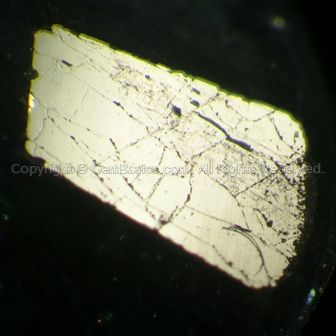
Thin surface-reaching cracks in ruby with early treatment
18x (FoV ± 3mm) Refl, Pol
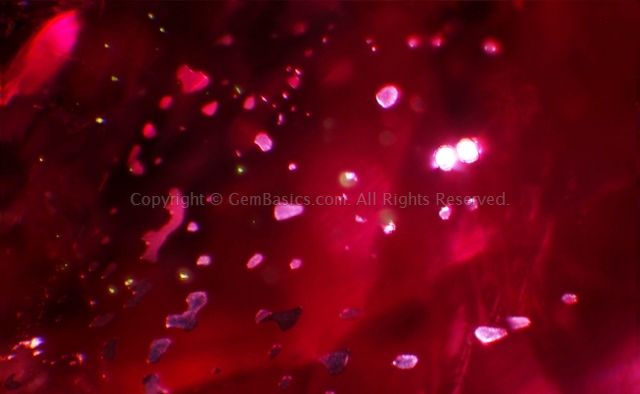
These cracks contain trapped gas bubbles which are typically flat in earlier treated stones
30x (FoV ± 2mm) Obl, DF, Pol

Cracks in more recently glass-filled rubies...
9x (FoV ± 3mm) Obl, DF, Pol
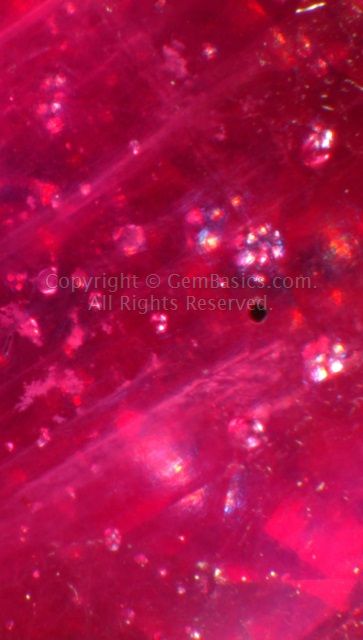
... are larger, and can host round bubbles
6x (FoV ± 5mm) Obl, DF, Pol
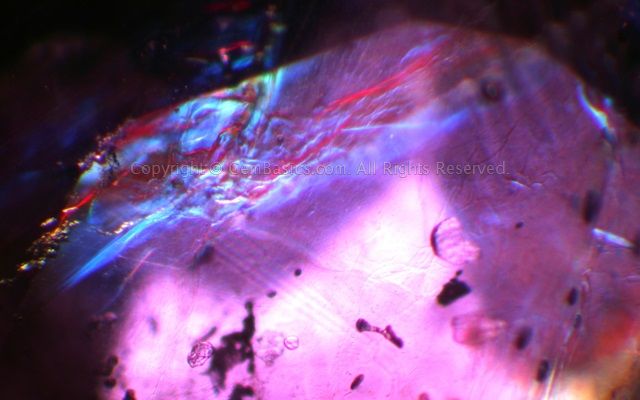
Colour flashes and a roiled structure are both caused by the lead glass filler
18x (FoV ± 2.5mm) Obl, DF, X-Pol


